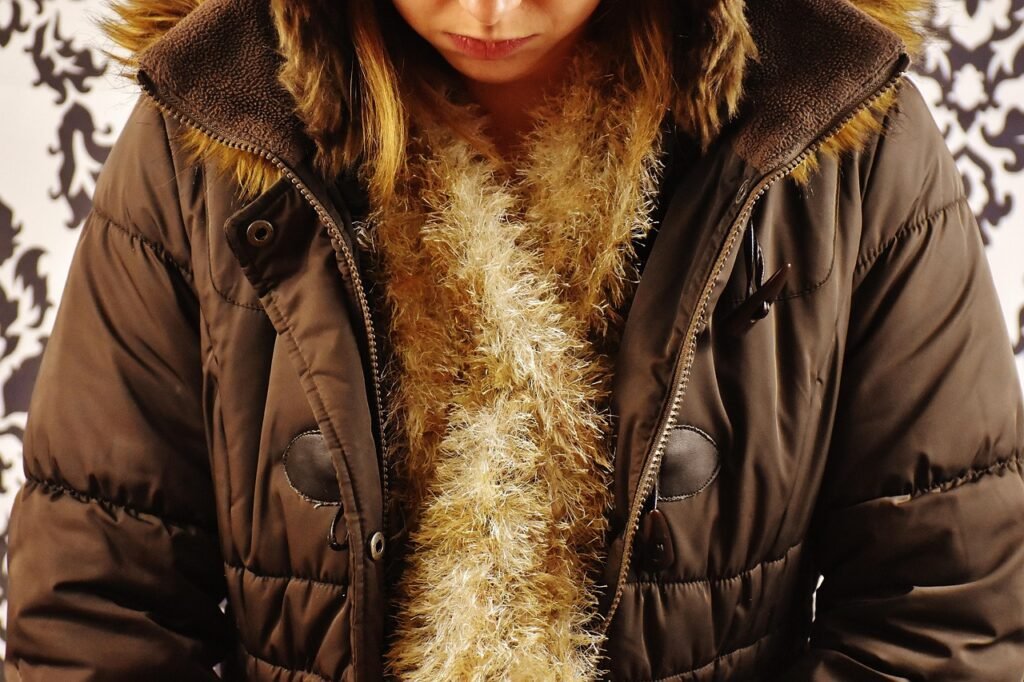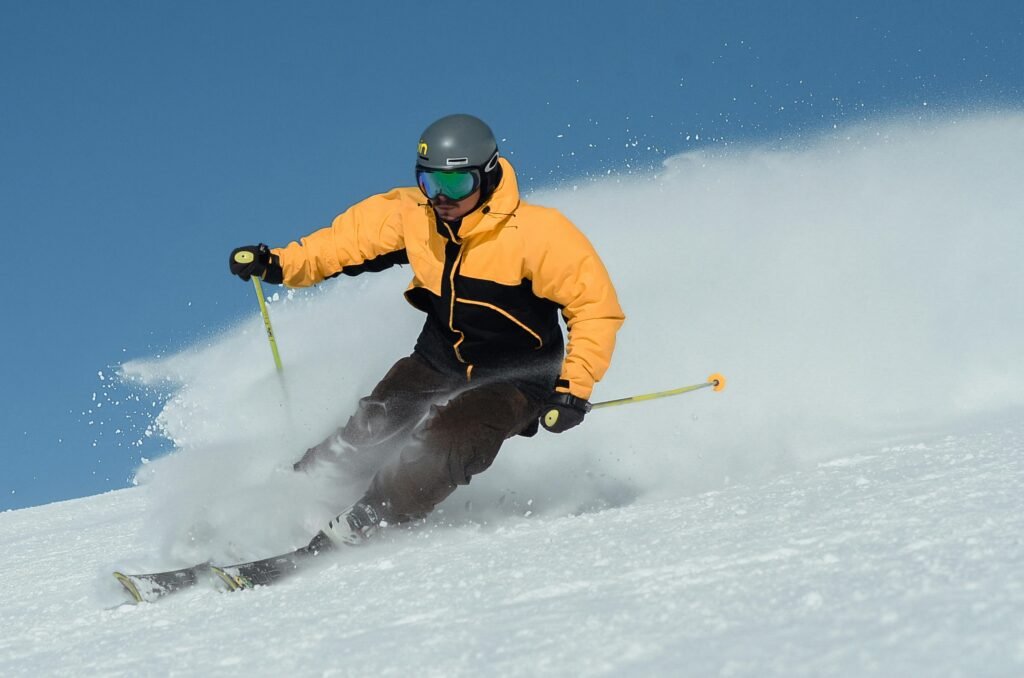After much trial and error, I’ve finally cracked the code to staying warm during Canada’s harsh winters. And guess what? It’s not as complicated as you might think! I’ve discovered four simple tricks that have completely transformed my winter experience. These easy-to-implement strategies have made such a difference that I now actually look forward to the snowy season. 👏
In this blog post, I’ll share my secrets to battling the cold and staying toasty warm, even when the mercury drops well below zero. From clever layering techniques to home optimization hacks, maintaining an active lifestyle, and nourishing your body from within, I’ve got you covered. So, grab a warm cup of cocoa ☕, and let’s dive into these game-changing winter survival tips!
First Trick | Stay Warm in Canada Winter: Layer Up Strategically

Choose moisture-wicking base layers
When it comes to staying warm in Canada’s frigid winters, I’ve learned that the foundation of any cold-weather outfit is a good base layer. I always start with moisture-wicking materials that keep my skin dry and comfortable. From my experience, synthetic fabrics like polyester or nylon blends work wonders. They’re designed to pull sweat away from my body, preventing that dreaded clammy feeling that can lead to chills.
I’ve found that merino wool is another excellent option for base layers. It’s natural, sustainable, and has incredible temperature-regulating properties. Plus, it’s surprisingly soft against my skin. Whether I’m hitting the slopes or just running errands in town, a good merino wool undershirt and leggings keep me cozy without overheating.
Here’s a quick comparison of my favorite base layer materials:
| Material | Pros | Cons |
|---|---|---|
| Synthetic Blends | Excellent moisture-wicking, Quick-drying, Durable | Can retain odors, Less eco-friendly |
| Merino Wool | Natural temperature regulation, Odor-resistant, Sustainable | More expensive, Requires special care |
| Silk | Lightweight, Soft, Good for layering | Less durable, Can be expensive |
I always make sure my base layers fit snugly but not too tight. This ensures they work effectively to wick away moisture and provide insulation without restricting my movement.
Opt for insulating mid-layers
Once I’ve got my base layer sorted, I focus on the mid-layer. This is where I really trap the heat and create a cozy buffer against the cold Canadian air. Fleece has been my go-to for years. It’s lightweight, breathable, and provides excellent insulation even when damp. I particularly love how it feels – like wearing a warm hug all day!
Down jackets or vests are another fantastic option for mid-layers. They offer an incredible warmth-to-weight ratio, making them perfect for those bitterly cold days when I need serious insulation without feeling like I’m wearing a sumo suit. However, I’m always careful to keep my down layers dry, as they lose their insulating properties when wet.
For a more budget-friendly and versatile option, I sometimes opt for synthetic insulation. It might not be quite as warm as down, but it performs better in damp conditions and is easier to care for.
Here are some key points I consider when choosing my mid-layers:
-
Thickness: Thicker doesn’t always mean warmer. I look for materials with good insulating properties.
-
Breathability: I want to stay warm without sweating excessively.
-
Versatility: Layers that can be easily added or removed as temperatures change throughout the day.
-
Compatibility: Mid-layers should fit comfortably under my outer shell.
Invest in a quality outer shell
The final piece of my layering puzzle is a good outer shell. This is my first line of defense against wind, rain, and snow, so I don’t skimp on quality here. I’ve learned that a well-made, waterproof, and breathable jacket is worth its weight in gold during a Canadian winter.
I look for jackets with sealed seams and water-resistant zippers to keep moisture out. Gore-Tex has been a reliable choice for me, offering excellent waterproofing without sacrificing breathability. However, there are other good options on the market too, like eVent or brand-specific technologies.
When choosing an outer shell, I consider these features:
-
Waterproofing: Essential for keeping me dry in wet snow or unexpected rain.
-
Windproofing: Crucial for those biting Canadian winter winds.
-
Breathability: Allows moisture from my base and mid-layers to escape.
-
Durability: Winter activities can be tough on clothing, so I choose materials that can withstand wear and tear.
-
Insulation: Some shells come with built-in insulation, which can be great for extremely cold days.
I’ve found that investing in a high-quality outer shell pays off in the long run. It not only keeps me warmer and drier but also tends to last longer, saving me money over time.
Don’t forget accessories: hat, gloves, and scarf
Now that we’ve covered the main layers, let’s talk about those all-important accessories. I can’t stress enough how much difference a good hat, pair of gloves, and scarf can make in frigid Canadian temperatures.
Starting with hats, I always make sure to cover my head when I step outside. We lose a significant amount of heat through our heads, so a warm hat is crucial. I prefer wool or fleece beanies that cover my ears. On particularly cold days, I might opt for a balaclava or a hat with ear flaps for extra protection.
When it comes to gloves, I’ve learned that one pair often isn’t enough. I use a layering system for my hands too:
-
A thin, moisture-wicking liner glove
-
A thicker insulating glove or mitten
-
A waterproof, breathable outer shell (for extremely cold or wet conditions)
This system allows me to adjust my hand protection based on the temperature and my activity level. If I’m doing something that requires dexterity, I can remove the outer layers while keeping my hands protected with the liner gloves.
Scarves or neck gaiters are my secret weapon against the cold. They protect my neck and can be pulled up to cover my face when the wind is particularly biting. I prefer materials like wool or fleece for their warmth and comfort.
Here’s a quick list of my must-have winter accessories:
-
Warm, insulating hat
-
Glove liners
-
Insulating gloves or mittens
-
Waterproof glove shells
-
Scarf or neck gaiter
-
Warm, moisture-wicking socks
-
Insulated, waterproof boots
By paying attention to these often-overlooked items, I’ve found I can stay much more comfortable in even the coldest Canadian weather.
Now that we’ve covered how to layer up strategically, let’s move on to how we can make our homes cozy havens during the long winter months. Proper insulation and smart heating strategies can make a world of difference in both comfort and energy bills.
Second Trick | Stay Warm in Canada Winter : Optimize Your Home for Warmth

Seal drafts and insulate windows
When it comes to staying warm during a Canadian winter, I’ve learned that one of the most effective strategies is to start with my home’s envelope. I’ve found that sealing drafts and insulating windows can make a world of difference in maintaining a cozy interior.
First, I always conduct a thorough draft check. I use a simple trick: on a windy day, I light a candle and slowly move it around the edges of windows and doors. If the flame flickers, I’ve found a draft. Once identified, I seal these gaps using weatherstripping or caulk. It’s amazing how much heat can escape through tiny cracks!
For windows, I’ve discovered that applying plastic film insulation kits can significantly reduce heat loss. These kits are inexpensive and easy to install. I simply attach the plastic to the window frame with double-sided tape and then use a hairdryer to shrink it tight. The result is an extra layer of insulation that’s nearly invisible.
Use heavy curtains or thermal blinds
After sealing and insulating my windows, I take it a step further by using heavy curtains or thermal blinds. This additional layer acts as a barrier against the cold air that naturally collects near windows.
I prefer thermal curtains because they’re specifically designed to block out cold. They typically have a layer of acrylic foam between the fabric layers, which provides excellent insulation. I make sure to hang them as close to the window as possible and let them fall to the floor for maximum effectiveness.
For a more modern look, I sometimes opt for cellular shades. These honeycomb-shaped blinds trap air in their cells, creating an insulating barrier. I find them particularly effective in rooms where I want to maintain a sleek appearance while still keeping warm.
Here’s a comparison of different window treatments and their insulating properties:
| Window Treatment | Insulation Value | Light Control | Cost |
|---|---|---|---|
| Thermal Curtains | High | Excellent | $$$ |
| Cellular Shades | High | Good | $$$$ |
| Regular Curtains | Moderate | Good | $$ |
| Venetian Blinds | Low | Excellent | $$ |
Invest in a programmable thermostat
One of the best investments I’ve made for my home’s warmth and energy efficiency is a programmable thermostat. This clever device allows me to set different temperatures for different times of the day, ensuring I’m not wasting energy heating an empty house or overheating while I sleep.
I typically program my thermostat to lower the temperature by a few degrees when I’m at work or sleeping, and to warm up the house just before I wake up or return home. This way, I maintain comfort while reducing my energy consumption and costs.
Some key benefits I’ve experienced with my programmable thermostat include:
-
Reduced energy bills
-
Increased comfort through consistent temperatures
-
Convenience of automatic temperature adjustments
-
Ability to control temperature remotely (with smart models)
For those looking to take it a step further, I recommend considering a smart thermostat. These devices learn your habits over time and can make automatic adjustments to optimize both comfort and energy efficiency.
Utilize space heaters safely
While central heating is great, I’ve found that strategic use of space heaters can help me stay warm without heating my entire home. This is particularly useful in larger houses where I might only be using one or two rooms at a time.
When using space heaters, safety is my top priority. Here are some guidelines I always follow:
-
Keep heaters at least 3 feet away from flammable objects
-
Never leave a space heater unattended
-
Always plug heaters directly into wall outlets, never extension cords
-
Choose models with automatic shut-off features
-
Ensure the heater is placed on a level, flat surface
I prefer ceramic heaters for their energy efficiency and safety features. They heat up quickly and maintain a consistent temperature. For larger spaces, I sometimes use an oil-filled radiator heater. These take longer to warm up but retain heat well and are very quiet.
Embrace cozy textiles: blankets and rugs
The final touch in my winter warmth strategy is to embrace cozy textiles throughout my home. I’ve found that strategically placed blankets and rugs not only add warmth but also create a inviting atmosphere that makes the cold outside more bearable.
I keep throw blankets on my couch and armchairs for easy access. My favorite is a thick, wool blanket that’s perfect for snuggling under while watching TV or reading a book. For the bedrooms, I use flannel sheets and a down comforter to ensure a warm and cozy night’s sleep.
Rugs play a dual role in my winter warmth strategy. They add a layer of insulation to cold floors, especially important if I have hardwood or tile. Plus, they help to visually warm up a room. I prefer thick, plush rugs in warm colors like deep reds or rich browns to enhance the cozy feel.
Here’s a list of my favorite textiles for winter warmth:
-
Wool throw blankets
-
Fleece blankets for extra softness
-
Flannel sheets
-
Down or down-alternative comforters
-
Faux fur throws for a touch of luxury
-
Thick, plush area rugs
-
Knit poufs or ottomans for both seating and warmth
By implementing these strategies to optimize my home for warmth, I’ve found that I can significantly reduce my energy consumption while staying comfortable throughout the harsh Canadian winter. From sealing drafts to embracing cozy textiles, each step contributes to creating a warm haven from the cold outside. With these measures in place, I’m ready to face whatever winter throws my way, knowing that I’ll always have a warm and inviting space to return to at the end of the day.
Third Trick | Stay Warm in Canada Winter: Maintain an Active Lifestyle

Engage in indoor exercises
When the Canadian winter hits hard, it’s tempting to curl up under a blanket and hibernate until spring. But I’ve found that staying active is one of the best ways to keep warm and maintain my health during these chilly months. Indoor exercises have become my go-to solution for staying fit and generating body heat without braving the icy outdoors.
I start my day with a quick 15-minute yoga session. It’s amazing how a few sun salutations can warm up my body and prepare me for the day ahead. I focus on dynamic poses that get my blood flowing, like warrior sequences and vinyasa flows. Not only does this practice warm me up physically, but it also helps me maintain a positive mindset throughout the day.
For a more intense workout, I’ve fallen in love with high-intensity interval training (HIIT). These short bursts of activity really get my heart pumping and my body temperature rising. I use a combination of bodyweight exercises like jumping jacks, burpees, and mountain climbers. Here’s a simple HIIT routine I follow:
| Exercise | Duration | Rest |
|---|---|---|
| Jumping Jacks | 30 seconds | 10 seconds |
| Push-ups | 30 seconds | 10 seconds |
| High Knees | 30 seconds | 10 seconds |
| Squats | 30 seconds | 10 seconds |
| Burpees | 30 seconds | 10 seconds |
I repeat this circuit 3-4 times, and by the end, I’m definitely not feeling the chill anymore!
On days when I want a lower-impact workout, I turn to indoor cycling. I invested in a stationary bike, and it’s been a game-changer for my winter exercise routine. I can pedal away while watching my favorite shows or listening to podcasts. It’s a great way to multitask – staying warm, getting fit, and catching up on entertainment all at once.
Try winter sports for fun and warmth
While indoor exercises are great, I’ve discovered that embracing winter sports is an exhilarating way to stay warm and enjoy the Canadian winter. At first, I was hesitant to venture out into the cold, but once I gave it a try, I found myself looking forward to these activities.
Ice skating has become one of my favorite winter pastimes. Whether it’s at an indoor rink or on a frozen lake (always ensuring it’s safe, of course), gliding across the ice gets my blood pumping and my cheeks rosy. I’ve found that the key to staying warm while skating is to keep moving. I practice figure eights, backwards skating, and even attempt a few simple jumps to keep my body temperature up.
Snowshoeing is another winter sport I’ve grown to love. It’s a fantastic full-body workout that allows me to explore beautiful snow-covered landscapes. The effort required to trudge through deep snow really warms me up quickly. I make sure to dress in layers that I can easily remove as I heat up during the trek.
For an adrenaline rush and a sure-fire way to generate heat, I’ve taken up cross-country skiing. It’s an incredible cardiovascular workout that engages nearly every muscle in my body. I’ve found that within minutes of starting, I’m shedding layers and feeling toasty warm, even on the coldest days.
Here’s a quick comparison of these winter sports based on my experience:
| Sport | Intensity | Equipment Needed | Warming Effect |
|---|---|---|---|
| Ice Skating | Moderate | Skates, Helmet | High |
| Snowshoeing | Low to Moderate | Snowshoes, Poles | Moderate |
| Cross-country Skiing | High | Skis, Poles, Boots | Very High |
Remember, the key to enjoying these winter sports is proper gear. I always make sure to wear moisture-wicking base layers, insulating mid-layers, and a waterproof outer layer to stay dry and warm.
Keep moving throughout the day
Staying active doesn’t just mean setting aside time for dedicated workouts or winter sports. I’ve learned that incorporating movement into my daily routine is crucial for maintaining warmth and energy levels during the Canadian winter.
One simple trick I use is to take frequent breaks from sitting. Every hour, I make a point to stand up and do a quick set of exercises. This could be as simple as 10 squats, a minute of marching in place, or a few stretches. These micro-workouts keep my blood circulating and help prevent the chill that often comes with prolonged inactivity.
I’ve also started using a standing desk for part of my workday. Alternating between sitting and standing not only improves my posture but also keeps me warmer. When I’m standing, I often find myself doing small movements like calf raises or gentle twists, which all contribute to generating body heat.
Walking has become an integral part of my daily routine, even in winter. Instead of dreading trips to the mailbox or taking out the trash, I view them as opportunities to move and warm up. I’ve even started purposely parking farther away from entrances when running errands to get in a few extra steps.
To make indoor movement more fun, I’ve incorporated dance breaks into my day. When I’m feeling cold or sluggish, I’ll put on an upbeat song and dance like nobody’s watching. It’s a quick and enjoyable way to raise my body temperature and boost my mood.
Here are some easy ways I incorporate movement into my daily routine:
-
Take the stairs instead of the elevator
-
Do light housework like vacuuming or dusting
-
Play active video games that require physical movement
-
Practice balance exercises while brushing teeth or waiting for the kettle to boil
-
Do leg lifts or arm circles while watching TV
By keeping active throughout the day, I’ve found that I’m better able to maintain a comfortable body temperature without relying solely on external heat sources. Plus, these small movements add up, contributing to my overall fitness and well-being.
As we move forward, it’s important to remember that staying warm in the Canadian winter isn’t just about physical activity. What we put into our bodies plays a crucial role in how we feel and function in cold weather. Let’s explore how nourishing our bodies from within can help us stay warm and healthy during the winter months.
Fourth Trick | Stay Warm in Canada Winter: Nourish Your Body from Within
Consume warm, hearty meals
As a Canadian resident who’s weathered many frigid winters, I’ve learned that one of the best ways to stay warm from the inside out is by consuming warm, hearty meals. I find that these dishes not only provide comfort but also help maintain my body temperature during the coldest months.
My go-to winter meals often include:
-
Hearty soups and stews
-
Casseroles
-
Roasted meats and vegetables
-
Warm grain bowls
-
Comforting pasta dishes
These types of meals are not only satisfying but also provide the necessary calories and nutrients to keep my body fueled and warm. I’ve noticed that incorporating more protein and healthy fats into my diet during winter helps me feel fuller for longer and maintains my energy levels.
One of my favorite winter recipes is a hearty beef stew. Here’s a simple breakdown of the ingredients I use:
| Ingredient | Amount |
|---|---|
| Beef chuck | 2 lbs |
| Potatoes | 3 large |
| Carrots | 4 |
| Onions | 2 |
| Celery | 3 stalks |
| Beef broth | 4 cups |
| Red wine | 1 cup |
| Herbs | To taste |
This stew not only warms me up but also fills my home with a comforting aroma that makes the cold outside more bearable.
Stay hydrated with hot beverages
While it might seem counterintuitive, staying hydrated is crucial for maintaining body heat during winter. I’ve found that hot beverages are an excellent way to achieve this while also warming myself up from the inside.
Some of my favorite winter beverages include:
-
Herbal teas (chamomile, peppermint, ginger)
-
Hot chocolate (made with dark chocolate for added antioxidants)
-
Mulled cider
-
Warm lemon water with honey
-
Bone broth
I make it a point to keep a thermos of hot tea or broth with me when I’m out and about. It’s not only a great way to stay warm but also helps me avoid the temptation of sugary coffee shop drinks.
One tip I’ve learned is to start my day with a large mug of warm water with lemon. This not only hydrates me after a night’s sleep but also gives my metabolism a gentle boost, helping me feel warmer throughout the morning.
Incorporate warming spices into your diet
Over the years, I’ve discovered the power of warming spices in my winter diet. These spices not only add flavor to my meals but also help increase circulation and metabolism, contributing to a feeling of warmth.
Some of the warming spices I regularly use include:
-
Cinnamon
-
Ginger
-
Turmeric
-
Cayenne pepper
-
Cumin
-
Cardamom
-
Black pepper
I’ve found creative ways to incorporate these spices into my daily routine. For instance, I add a pinch of cinnamon to my morning coffee or oatmeal. I use ginger and turmeric in my stir-fries and soups. Even a dash of cayenne pepper in hot chocolate can create a delightful warmth that spreads throughout my body.
One of my favorite winter drinks is a golden milk latte. Here’s my simple recipe:
-
1 cup of milk (dairy or plant-based)
-
1/2 teaspoon turmeric
-
1/4 teaspoon cinnamon
-
1/4 teaspoon ginger
-
A pinch of black pepper
-
Honey to taste
I heat all ingredients in a small saucepan, whisk until frothy, and enjoy this warming, comforting drink before bed.
Consider supplements for immune support
While I always prioritize getting nutrients from whole foods, I’ve found that certain supplements can be beneficial during the harsh Canadian winters, especially for maintaining a strong immune system.
Some supplements I consider during winter include:
-
Vitamin D: With less sunlight exposure, I often take a Vitamin D supplement to support my immune system and mood.
-
Omega-3 fatty acids: These help support overall health and can aid in reducing inflammation.
-
Probiotics: To support gut health, which is closely linked to immune function.
-
Vitamin C: For additional immune support, especially during cold and flu season.
-
Zinc: Another immune-boosting mineral that I find helpful during winter.
Before starting any new supplement regimen, I always consult with my healthcare provider to ensure it’s appropriate for my individual needs.
I’ve noticed that by focusing on nourishing my body from within, I’m better equipped to handle the cold Canadian winters. It’s not just about staying physically warm; it’s about maintaining overall health and well-being during the challenging winter months.
As we move forward, it’s important to remember that staying warm in winter isn’t just about what we put on our bodies, but also what we put in them. By combining these nutritional strategies with the other tips we’ve discussed, such as layering up and optimizing our homes for warmth, we can create a comprehensive approach to thriving during the cold Canadian winters.
I’ve found that staying warm during Canada’s harsh winters doesn’t have to be complicated. By following these four simple tricks, I’ve managed to keep cozy even on the coldest days. Layering up strategically has been a game-changer for me, allowing me to adjust my clothing as needed throughout the day. I’ve also learned the importance of optimizing my home for warmth, which has made a significant difference in my comfort levels indoors.
Maintaining an active lifestyle has not only helped me stay warm but has also improved my overall well-being during the winter months. Lastly, I’ve discovered that nourishing my body from within with warm, hearty meals has been crucial in battling the cold. I encourage you to try these tricks and find what works best for you. With a little preparation and mindfulness, you can embrace the Canadian winter and even learn to enjoy its unique beauty.

